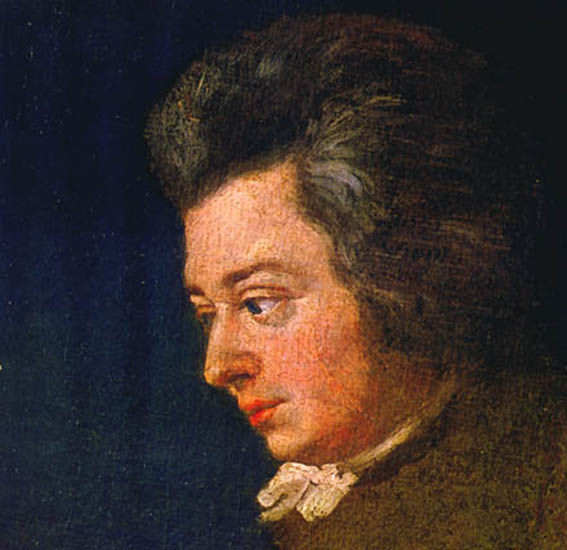Wolfgang Amadeus Mozart (1756-1791)
Born January 27, 1756 in Salzburg, Austria.
Died December 5, 1791 in Vienna, Austria.

Symphony No. 29
Composed Spring 1774.
Instrumentation: 2 oboes, 2 horns (A and D), Violins I & II, Viola, Violoncello, Bass.
Duration: ~ 21 minutes (7:30, 6:00, 3:00, 5:00).
Although he was recently employed by Archbishop Colloredo in Salzburg, Mozart and his father spent the summer of 1773 in Vienna unsuccessfully trying to find employment at the Imperial Court. Unfortunately, the 17 year old Mozart did not find the same favor from the empress as he did when he was 8:
“You asked me about taking into your service, the young Salzburger. I cannot think what as, for I do not believe that you have any need of a composer or of useless persons.” – letter from Empress Maria Teresa to her son Archduke Ferdinand.
The visit wasn’t a complete waste of time, however, because the young composer heard new music, especially Haydn’s new works that was to influence his later works.
In the fall of 1773, he composed his first symphonies to become part of the standard repertoire – the Symphony No. 25 in G minor, K. 183 followed by the structurally similar Symphony No. 29 in A Major the following spring. The manuscript of No. 29 bears an inscription that it was completed on April 6, 1774, but the month and day were scratched out.
In both symphonies, Mozart moved from the three-movement Italian Sinfonia form of his earlier symphonies to four movements (although not for the first time) by adding a minuet – the only movement that is not in sonata form.
- Allegro moderato
- Andante
- Menuetto: Allegretto – Trio
- Allegro con spirito
The Allegro moderato first movement begins softly with a distinctive and easily recognized figure of an octave drop followed by an undulating figure. Not content with a simple presentation of the theme, as early as measure 13 Mozart begins treating it contrapuntally between the violins and lower strings. After a repeat of the first theme and a modulation, the gentler second theme appears which is also repeated. Another modulation to a closing theme leads into the development which visits D and F# minor for two variations. The structure of the recapitulation mirrors the exposition. The counterpoint continues in the coda where the opening theme is tossed between all four string sections.
The Andante second movement in D major is also in sonata form, but has more of a character of a peaceful serenade than a symphony. The strings are muted which underscores this intimacy. Mozart is not content with making the second violins supporting players. For example, after the first violins introduce the gently flowing first theme, it is the second violins who play it on the repeat with the firsts playing a secondary embellishment.
The 3/4 Menuetto third movement returns to A major. It is permeated with
the opening dotted rhythm along with abrupt dynamic changes. This minuet is removed from the courtly dance and resembles a country dance, with a graceful trio offering a delightful contrast.
The Allegro con spirito finale immediately recalls the first movement by opening with octave drop. As in the Andante, the second violins frequently come to the fore while the first violins play embellishments. The first theme is followed by a horn like motif echoed by the violins. This motif suggests the hunt, which is a perfect description of the joyful character of the finale. The music is ebullient and virtuosic, culminating in a celebratory conclusion.
Resources
Public Domain Score at IMSLP.
Karajan.
Unknown performers.


